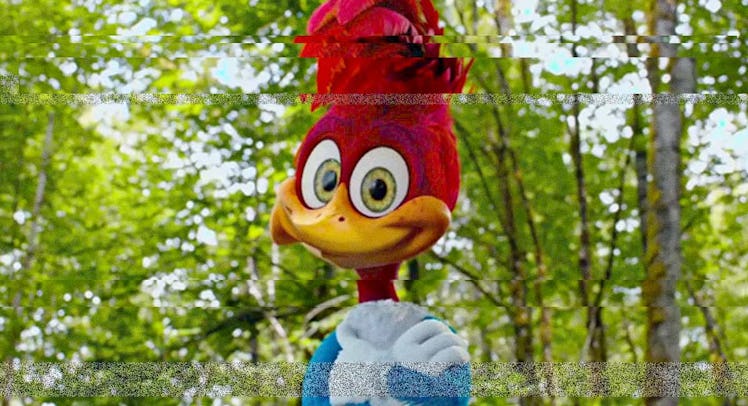What the New ‘Woody Woodpecker’ Movie Says About Kids Entertainment
The new movie from Warner Bros. is definitely low budget -- and that's the most interesting thing about it.

Warner Bros. just quietly released a very loud, live-action Woody Woodpecker movie on DVD and on-demand after what may have been the most subtle marketing campaign in the history of children’s entertainment. In the age of overhyped reboots, Woody got minimum attention and basically no ink. That fact is especially given that Woody Woodpecker is not an especially bad movie. It’s by-the-numbers and slight, but funny in places and not as annoying as it could be (what with the catchphrase and all) or demonstrably worse than, say, the Emoji Movie. What the movie might be is broadly indicative of the direction children’s entertainment could be taking as the production of CGI-intensive movies that would have once commanded Space Jam-level budgets becomes significantly easier.
The film tells the story of a greedy businessman who threatens to destroy the Pinegrove Forest of Pennsylvania because he believes that “big projects are the next big thing.” The only woodland creature standing in his way? Our titular hero, a fast-talking, mischievous woodpecker who teams up with the businessman’s son to help melt dad’s cold heart and save the forest. As is the case with most middling kid’s movies, Woody Woodpecker relies less on plot than on lazy slapstick and phoned-in performances from human actors. Still, Woody Woodpecker has a solid message about conservation and brings Woody back to his roots as a havoc-wreaking weirdo. He’s basically Edward Abbey with ADHD and that kinda works.
But why is Woody Woodpecker making his cinematic comeback in a direct-to-DVD live-action movie (a modest hit in Brazil!) that won’t garner much attention? The answer seems to have a lot to do with the character’s history and with, well, money. Ironically, Woody Woodpecker is indicative of the fact that the next big thing might actually be small projects.
Historically, there’s little debate over the fact that Woody Woodpecker is an icon in animation. Sure, he may never have been on the level of transcendent legends like Bugs Bunny or Mickey Mouse but he was a prominent and beloved figure in the Golden Age of animation. The character first began to appear in cartoons in the late 1930s and his distinct voice (and laugh) along with his slightly unhinged, screwball sensibilities quickly made him popular with kids.
Yet Woody faded from the public consciousness. While his animated contemporaries, including the Looney Tunes and the Disney menagerie, were able to remain relevant, Woody had wandered off into the wilderness by the late 1970s. Eager to retain IP, Warner Bros. foolishly tried to revamp the wild and crazy bird as a mild-mannered protagonist trying his best to do good in the world. This did not work and Woody more or less retired to drink grub-garnished martinis.
Why return now? The most plausible answer is margins. A decade ago, making a live-action movie with an animated main character was debilitatingly expensive. It isn’t anymore. The movie cost roughly $10 million to make. Compare that to the $125 million that went into Boss Baby. Sure, the two films will have very different ROIs, but Woody Woodpecker will represent small win created without much risk. If it made zero dollars it would have been a minor right down — not even worth mentioning for a studio head. And the film had and has real upside. If it rises up the on-demand charts, Warner Bros. will be looking at proof that the character still has legs (or wings or what have you).
The movie might be best understood as a reboot beta test or as a trial balloon. How do you bring an old character back into the mainstream? The answer used to be, “throw a ton of money around.” The answer may now be, “run a trial and see how it goes.” Thanks to advancements in technology, that’s possible. This represents the best possible news for Atom Ant, Auggie Doggy, Huckleberry Hound, and Top Cat, who might get to cause some low-budget chaos in the real world.
All that said, animation is hard. We’re not quite to the point where movies like this can be successfully mass produced. In the film, Woody doesn’t feel like a fully realized character so much as a photoshop glitch. The CGI is terrible. Woody makes the shark attack from Deep Blue Sea look like that flying scene from Avatar. Kids may not care or even notice, but it’s hard to root for a character trying to protect the uncanny valley from development. It’s impossible to get emotionally attached to an animated pop-up window.